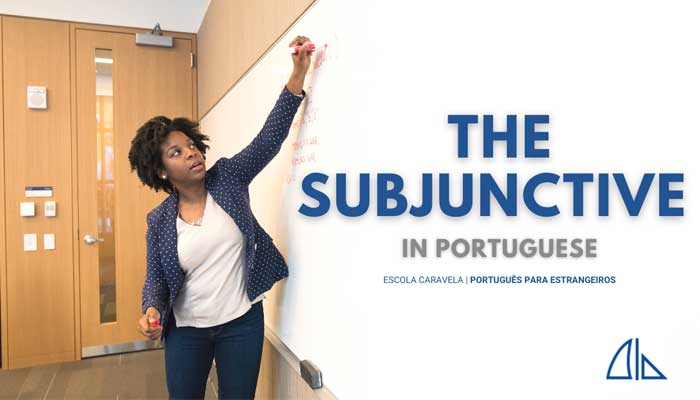In a higher intermediate level students start to learn and use a new mode: the subjunctive. For many students, after a time mastering the Indicative mode, it could be a new headache. So, today we will simplify this mode in order to help you to understand when you should use it. In other words, you will learn the differences between the modes.

The four tense moods
In Portuguese language there are four conjugated modes: indicative (indicativo), imperative (imperativo), conditional (condicional) and subjunctive (conjuntivo).
First questions is “what’s the difference between them?”. Basically, we can distinguish them in the follow way:
Indicativo: expresses facts/something real in the past, present or future.
Eu estudei/estudo/estudarei em Portugal. (I learnt/learn/will learn in Portugal)
About past and present it’s easy to understand that they are facts. About future, is more difficult, because we are talking about something that didn’t happen yet. However, in Portuguese when we say “I will study in Portugal” it’s considered a something real. That’s because there are no expressions of uncertainty or dependence in that sentence.
Imperativo: for orders, advices, requests.
Faz o trabalho de casa. (Make the homework)
Condicional: a possibility depending on a condition; a desire or a request (in a more formal way).
Compraria um carro novo, mas não tenho dinheiro. (I would by a new car, but I have no money)
Gostaria de morar em Lisboa. (I would like to live in Lisbon)
Conjuntivo: doubt, possibility or desire in past, present or future.
Understanding the two parts of a phase
First step to understand when we should use the subjunctive mode is to understand that some phrases can be divided into two connected sentences. Let’s see an example:
Quando chegar a casa, telefono-te. (When I get home, I call you).
This phrase has two parts “chegar a casa” and “telefono-te” connected by the word “quando”. We can change the order:
Telefono-te quando chegar a casa.
“Telefono-te” (I call you) expresses itself an idea, so it’s the main part (oração subordinante). “Quando chegar a casa” (when I get home) it’s incomplete, so it’s the depending part (oração subordinada): it needs the main part to make sense.
As you can see, in the main part the verb is in the indicative mode (telefono), but in the depending part it’s in the subjunctive. In this case, is the future of subjunctive (which coincides with the infinitive).
When to use the Subjunctive
As you already know, when a phrase has two parts (the main and the depending one), there is always a connecting word. If you know which connecting words demand the subjunctive mode, you’ll understand when to use it.
Today we will talk about three of these words, the most used and important to understand this mode. These words are “que” (the main one), “se” and “quando”.
The word “que”
When this word connects two parts, and the subjects are different, the “depending” verb will be in the subjunctive mode:
Espero que o exame seja fácil. (I hope the exam will be easy)
Queres que eu te ajude? (Do you want I help you?)
Prefiro que me telefones de manhã. (I prefer that you call me in the morning)
In the sentences above, the underline verbs are in the subjunctive, because the subject in the main part is different. If the subject was the same, we wouldn’t use it, as you can see below:
Espero ter um bom resultado no exame. (I hope to have a good result on exam)
Queres ajudar-me? (Do you want to help me)
Prefiro telefonar-te de manhã. (I prefer to call you in the morning)
In these cases we don’t conjugate the second verb: it stays in the infinitive.
Consequently, we can conclude that, if there is only one subject, the easiest form is the second one, with the infinitive.
The words “se” and “quando”
We use these words very often, because we use them to express possibilities and conditions.
“Quando” is used to talk about events in future. Let’s see examples:
Quando eu for a Coimbra, vou visitar o meu irmão. (When I will go to Coimbra, I will visit my brother)
Again, we have one depending part connected to the main part by the word “quando”. Here no matters the number of subjects: the verb in the depending part it’s in the subjunctive mode. Although, if we say:
Eu vou a Coimbra e vou visitar o meu irmão. (I will go to Coimbra and I will visit my brother)
Here we don’t use the Subjunctive because both parts are “independent”. Also, if we are talking about the past:
Quando fui a Coimbra, visitei o meu irmão. (When I went to Coimbra, I visited my brother).
Here we use the Indicative as well because we are talking about something that already happened in the past, which is a fact.
We can use “se” in this context as well, but to express a condition:
Se for a Coimbra, visito o meu irmão. (If I go to Coimbra, I will visit my brother).
“Se” is also used with past forms of subjunctive, but about this we will talk about in a next article.
Conclusion
As we use to do, we’ve tried to simplify as much as possible, not focused in technical terms, but in a practical way to feel how to use it. This is the first part, where we showed the fundamentals and the most frequent cases. So, if you want to learn more, follow us and wait to the second part.
Finally, if you want to learn more and practice your skills in a friendly environment, join to our courses in one of Schools Caravela or online as well.
Até já!
